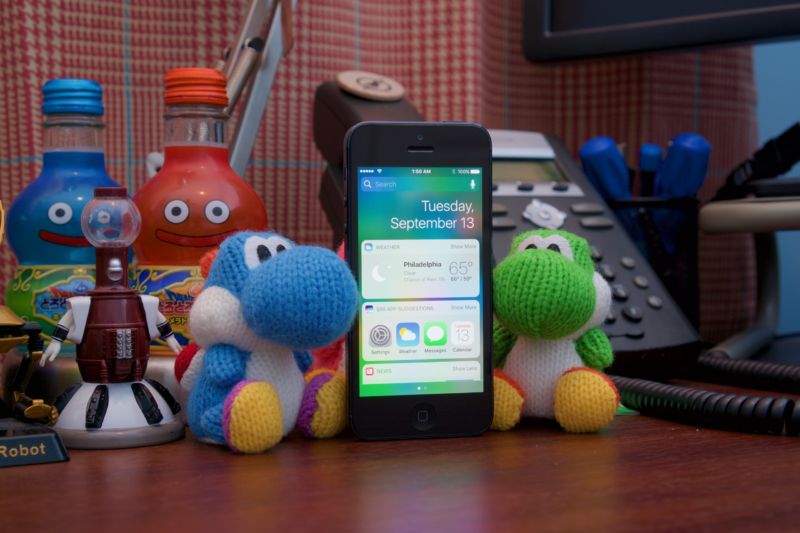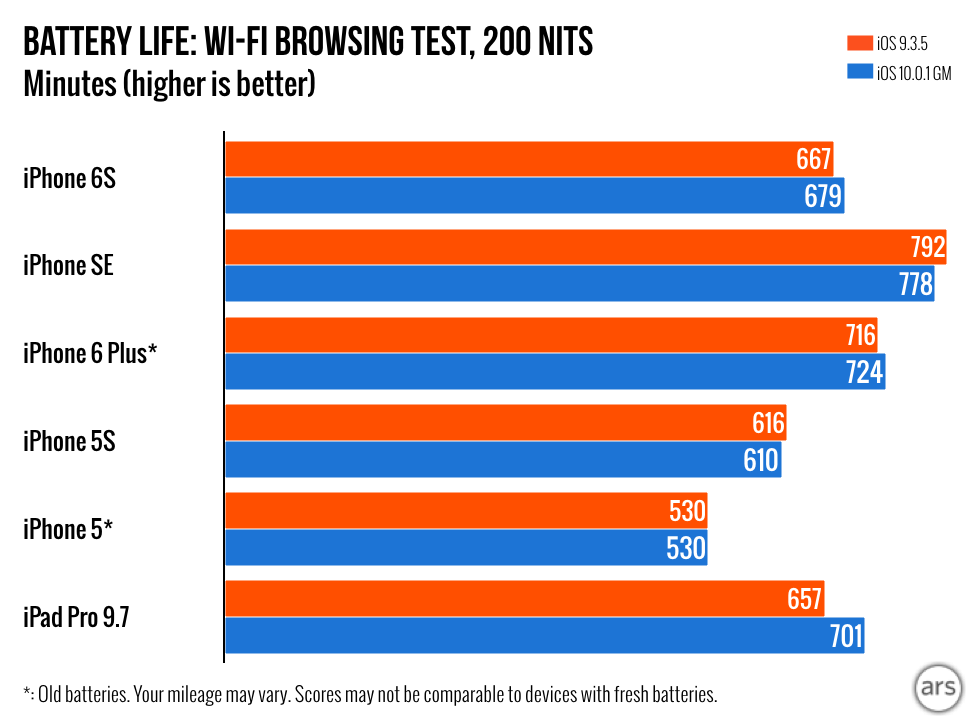
I’ve been tracking the performance of new iOS versions on the slowest supported hardware for four years now, and I don’t think my findings have been positive since I wrote about iOS 6 on the iPhone 3GS. iOS 7 was a bad fit for the iPhone 4, and iOS 7.1 was only an improvement in a relative sense. iOS 8 and iOS 9 were tolerable on the iPhone 4S, but they were still significant slowdowns compared to iOS 6 and 7.
But we have some reason to be optimistic about iOS 10 on the iPhone 5. The phone is more than twice as fast as the 4S and has double the RAM. Its screen is the same size and resolution as the one in the just-launched iPhone SE, so you know that Apple and all other app developers are still fine-tuning their apps for it.
So how enthusiastic should iPhone 5 and 5C owners be about iOS 10? Can you get the new features without worrying about a slowdown, or should you give Apple some more time to optimize (or more money for another phone)?
What you’re missing
Every time a new iPhone is released, it does some stuff that previous iPhones couldn’t do. Sometimes that just means going faster, and sometimes that means the addition of special hardware like a fingerprint sensor or NFC chip. Here’s a combination of all the hardware and software features the iPhone 5 is missing relative to the iPhone 6S, not including processor benchmarks or camera improvements.
- TouchID and Apple Pay
- 3D Touch
- Voicemail transcription
- New Photos app features like Memories, Related, People, and Scene
- Night Shift
- Safari content blockers
- Raise-to-wake
- Step tracking without external hardware like an Apple Watch
- Burst photos and slow-mo video
- 64-bit and Metal API support.
That’s a not-insignificant list of things, but it’s also much shorter than the list for iPhone 4S with iOS 8 and 9. The iPhone 5 can do all of the Airdrop and Handoff stuff, and it supports the Apple Watch as well as all of iOS 10’s headlining APIs and app improvements.
Performance and battery life: iOS 9-ish
Comparing app launch times has historically been a reliable way to measure relative performance—it’s not the best, most all-encompassing real-world test, but the odds are good that if app launch times slow way down, the rest of the phone will feel slower as well. Luckily, most apps in iOS 10 launch about as quickly as they did in iOS 9, reflecting the fact that iOS 9 and iOS 10 mostly run similarly.
As always, these tests were run on freshly-reset phones signed into a test iCloud account. Each app was launched, force quit, and then launched again. The times below are the average of three launches.
| Application | iOS 9.3.5 | iOS 10.0.1 GM | Change |
|---|---|---|---|
| Safari | 1.55 seconds | 1.77 seconds | +14% |
| Camera | 1.03 seconds | 1.05 seconds | +2% |
| Settings | 1.02 seconds | 1.05 seconds | +3% |
| 1.17 seconds | 1.66 seconds | +42% | |
| Messages | 1.45 seconds | 1.72 seconds | +18.5% |
| Calendar | 1.04 seconds | 0.97 seconds | -7% |
| Cold boot | 37.1 seconds | 37.3 seconds | +0.5% |
For Camera, Settings, Calendar, and the boot process, these times are so close that most users won't notice a difference, and both Safari and Messages also manage to come pretty close. Mail is the only app that sees a modest slowdown with iOS 10 similar to the way most apps slowed down when the iPhone 4S jumped to iOS 8. In absolute terms all of these changes are small, and there is no sign of the across-the-board slowdown we saw on the iPhone 4 and iPhone 4S when they were updated to iOS 7 and iOS 8, respectively. You don't lose the feeling of general responsiveness and fluidity throughout the OS, something that's harder to measure with a stopwatch but which definitely contributed to the slowdown on those older devices.

Relative battery life is about the same too, though for reasons we’ll explore later the iPhone 5 can’t last as long as newer iPhones can running the same software.
These numbers are encouraging, but I also used the iPhone 5 as my main phone for a couple of days to get a sense of how it actually feels to use iOS 10 on it. Again, it’s mostly good news, at least if you’re happy with how the phone runs iOS 9.
Using the phone in real life
Most basic day-to-day things still feel pretty good on the iPhone 5. Bringing up the Intelligence screen, the Notification Center, the Control Center, or the multitasking switcher all happens smoothly without the inconsistency or dropped frames that plague an iPhone 4S running iOS 9. You’ll mostly run into problems in three areas: games, multitasking, and battery life.
The GPU in the iPhone 5S can be as much as three or four times faster than the GPU in the iPhone 5, and newer iPhone GPUs are even faster. That by itself is enough to explain why even simple-looking games like Pokémon Go and Shooty Skies can exhibit choppy framerates on the iPhone 5. They’re still playable, but performance is less consistent since the hardware is being pushed to its limits.
The same principle explains why multitasking—switching from one app to another, replying to a message directly from a notification, doing things with the phone while it’s also performing a background task like app updating or a large download—can make the phone chug a little. As long as you’re just doing one thing, the speed feels pretty good. The iPhone 5 launched with iOS 6, after all, software that was far more locked down and less capable than iOS is today.
And then there's battery life. Part of the problem stems from the older hardware—if the SoC is working harder than it did under older versions of iOS, that means that the chip spends less time idling, and idle time is where modern phones and laptops save power. The biggest battery life jumps in recent years have come because Apple, Intel, and others have figured out how to let their chips spend more time not doing anything and by making the processors switch between active and idle states more quickly. The iPhone 5 and 5C are working harder more often, so battery life is more of a problem than it is on a newer phone like the iPhone SE (that phone’s chips were all made using newer, more power-efficient manufacturing processes, which also helps).
The other factor is normal wear-and-tear. Any iPhone 5 or 5C out there right now is somewhere between two and four years old, and if your phone’s battery hasn’t been replaced at some point, you’ve probably lost a significant amount of capacity. Since those phones are also mostly out of warranty, it’s relatively easy to find a third-party who will change your battery out for a fresh one, and iFixit sells kits that make it relatively easy to do yourself. But if you or someone you know is using an older iPhone 5 or 5C at this point, a new battery is probably worth looking into.
The most important thing to note for the purposes of this article is that all of these things were also problems in iOS 9, and that iOS 10 doesn’t appear to make any of them worse. They’re just realities of using a phone made in 2012 to run software made in 2016. Phone hardware is maturing rapidly, but the year-over-year improvements are still noticeable, and cumulatively the last four years of updates are even more noticeable.
Should you update?
For the first time in a while, I’m comfortable recommending the latest version of iOS for the oldest-supported iPhone without major caveats or qualifications. Yes, newer iPhones are faster and can do more things, but if you’re still using an iPhone 5 or 5C (or if you’ve handed your old one down to someone else in your circle of family and friends), iOS 10 will treat the hardware about the same as iOS 9 did—not bad, given that the iPhone 5 is four years old.
I’ve always been frustrated by the “forced obsolescence” argument with respect to iPhones and iPads, and the fact that iOS 10 runs pretty well on the iPhone 5 makes it even more silly than it normally is. There is, to put it quite simply, no other company on Earth who is providing this kind of support for its phones. Not one. How many years has it been since Samsung even thought about the Galaxy S III? The HTC One X didn’t even make it two years. Microsoft ditched the Lumia 920 with the Windows 10 update despite promises that all Windows Phone 8 phones would be supported. Even Google won’t commit to keeping a phone around and up-to-date for more two years. And it’s getting to the point where any given Android phone maker couldn’t keep hardware updated for more than two or three years even if it wanted to.
iOS 10 treats the iPhone 5 pretty well, and I would expect this to gradually become the new “normal” as the gap between the newest, best iPhone and the slowest, oldest supported iPhone continues to narrow. Huge performance gains will get harder to come by as the smartphone settles into its boring middle age and as manufacturing smaller, more power-efficient chips becomes more difficult, and as a result your hardware should stop feeling old quite so quickly.
Our full iOS 10 review will be published later this afternoon.
reader comments
118